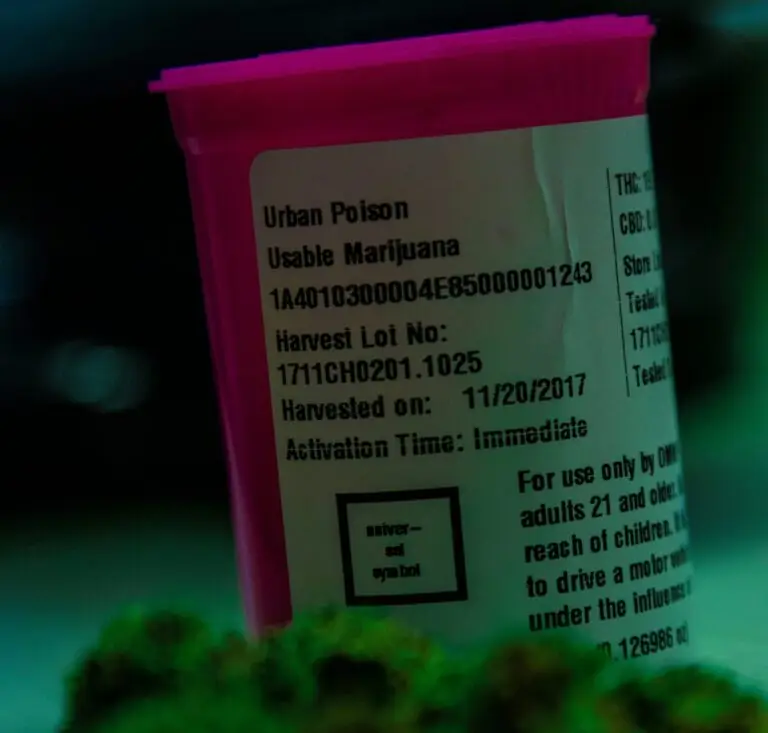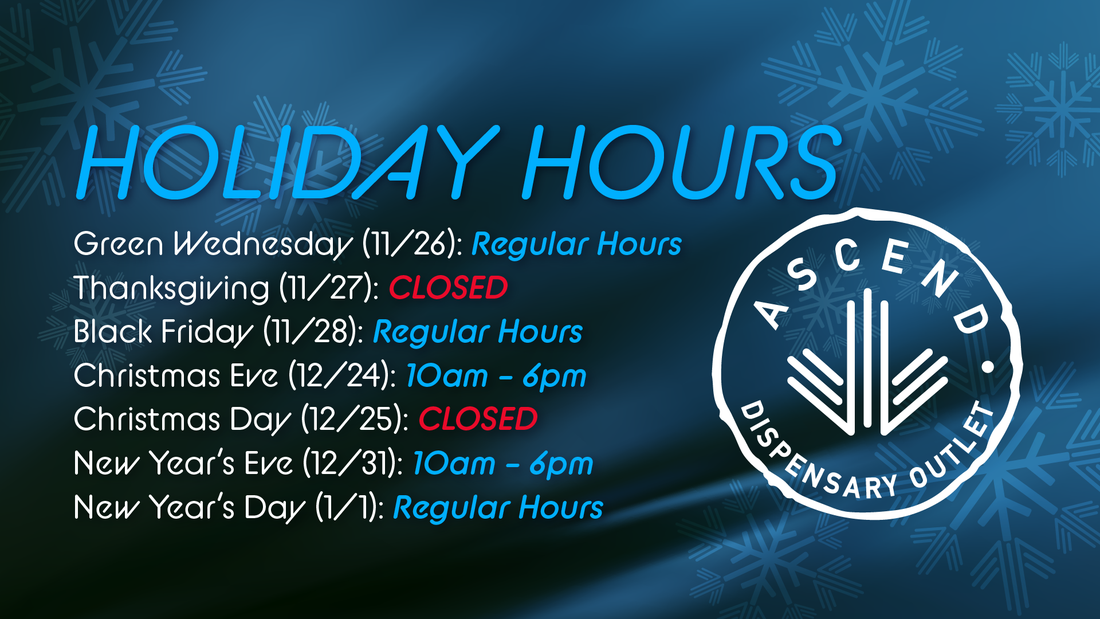Picture this: You walk into your favorite dispensary, ready to explore the shelves, but suddenly you’re staring at a product label that looks like it needs a PhD to decode. Between the THC percentages, mysterious acronyms, and tiny print warnings, you might feel like you need a translator just to buy some weed. Don’t worry—you’re definitely not alone in this struggle.
According to research published in the Journal of Cannabis Research in 2024, inadequate labeling and unclear packaging of cannabis products contribute to significant consumer safety concerns, highlighting the urgent need for better consumer education.
The good news? Once you know what to look for, reading cannabis labels becomes as easy as checking a nutrition label on your favorite snacks.
Whether you’re a curious newcomer or a seasoned enthusiast looking to level up your dispensary game, this guide will transform you from label-confused to label-confident. Let’s dive into the world of how to read dispensary labels and turn those intimidating stickers into your best shopping buddies.

Why Cannabis Labels Matter More Than You Think
Before we jump into the nitty-gritty details, let’s talk about why learning how to read a cannabis label—or more specifically, how to read a cannabis label and read a cannabis product label—is actually a game-changer for your cannabis experience. Think of dispensary labels as your personal roadmap to the perfect high—they’re packed with crucial information that can make or break your session.
Here’s the reality: cannabis labels are your safety net. They tell you exactly what you’re putting in your body, how much to take, and what to expect. According to a comprehensive study published in PMC, states require an average of 16.7 different label attributes, ranging from 4 to 26 pieces of information, depending on your location.
Beyond safety, labels help you:
Choose products that match your desired experience
Avoid overconsumption (we’ve all heard those edible horror stories)
Understand value and make budget-friendly decisions
Track what works best for your personal needs
The Essential Elements: Decoding Your Cannabis Labels
THC and CBD Content: The Power Players
The most important numbers on any cannabis label are the THC and CBD percentages. Think of these as the “nutrition facts” of your cannabis experience.
THC (Tetrahydrocannabinol) is the compound that gets you high. According to research from Reddit’s r/trees community analyzed in a 2024 PMC study, dabbing products typically show the highest subjective “highness” ratings, largely due to their concentrated THC levels that can reach up to 90%.
CBD (Cannabidiol) is the chill cousin that provides therapeutic benefits without the psychoactive effects. Recent studies show that CBD can actually counteract some of THC’s intensity through what scientists call the “entourage effect.”
Here’s how to interpret the numbers:
Flower products: Look for percentages (usually 15-30% THC for most strains)
Edibles: Check for milligrams per serving (typically 2.5-10mg of THC per serving for beginners, representing the THC per dose—not the THCA precursor)
Concentrates: Expect higher percentages (60-90% THC, converted from THCA during the extraction and heating process)
Serving Size and Total Package Content
This is where many people get tripped up, especially with edibles. Understanding edible onset times remains a challenge. As the survey found, many consumers still don’t understand that edibles can take up to 4 hours to show full effects, leading to accidental overconsumption.
Always check for:
Per serving amount: How much THC or CBD per dose
Total package content: How much total thc is in the container
Number of servings: How many doses you’re getting
For example, a package of gummies might contain 100mg of THC total (the total amount in the container), but if there are 10 gummies, each one contains 10mg of THC per serving—perfect for a moderate experience.
Batch Numbers and Testing Information
Every legitimate cannabis product should have a batch number and testing information. This isn’t just regulatory stuff—it’s your quality assurance.
According to PMC research, over 80% of states require batch numbers on cannabis labels, and for good reason. These numbers allow you to:
Track products back to their source if there are issues
Verify that your product has been tested for contaminants
Ensure consistency between purchases
Look for certificates of analysis (COAs) that show testing for:
Potency verification
Pesticides and heavy metals
Mold and bacteria
Residual solvents
Expiration Dates and Storage Instructions
Just like your favorite leftovers, cannabis products don’t last forever. Proper storage information helps maintain potency and safety. Most products will include “best by” dates and storage recommendations like “store in a cool, dry place” or “refrigerate after opening.”
Product-Specific Label Reading: Your Shopping Strategy
Flower Power: Reading Bud Labels
When shopping for cannabis flower, how to read the labels becomes about understanding strain information, harvest dates, and growing methods.
Key elements to look for:
Cannabis strain name and type (Indica, Sativa, or Hybrid) on flower labels
THC and CBD percentages (also shown as total active cannabinoids)
Terpene profiles (these compounds in cannabis that interact with cannabinoids affect flavor and the effects of cannabis)
Harvest date (which indicates when the cannabis was picked—fresher is usually better)
Growing method for the cannabis plant (indoor, outdoor, or greenhouse)
Edible Excellence: Navigating Food Labels
Edibles require extra attention because the effects are delayed and longer-lasting. Research published in Drug and Alcohol Dependence found that edible consumption is gaining popularity, particularly in states where cannabis has been legalized.
Essential information on marijuana labels and packaging labels for edibles:
Onset time (usually 30 minutes to 2 hours)
Duration of effects (typically 4-8 hours)
Serving size (often a fraction of the package)
Allergen information (crucial for food sensitivities)
Ingredient list (in order of abundance)
For topical cannabis products like creams and balms, many cannabis labels also display the cannabinoids present in the product, helping users understand active ingredient levels.
Concentrate Clarity: Understanding Extracts
Concentrates pack a serious punch, so label literacy is crucial. According to 2024 research published in PMC, concentrates averaged 3.4 times higher THC potency (and often higher THCA content, which determines the potency of a cannabis product) and 3.1 times higher CBD potency than flower products.
Look for:
Extraction method (CO2, butane, rosin, etc.), which differs from cannabis flower products or tincture labels that show cannabis oil content
Consistency type (shatter, wax, live resin)
Cannabinoid profile (full spectrum vs. isolate), which shows the cannabinoids found in cannabis including CBD in the product
Terpene retention (affects flavor and effects)
Safety First: Warning Labels and Legal Requirements
Cannabis labels aren’t just about getting you the right high—they’re also about keeping you safe. According to the CDC’s 2024 guidelines, pregnant and breastfeeding women should avoid cannabis, and labels must clearly state this warning.
Universal safety elements include:
“Keep out of reach of children” warnings
Impairment disclaimers about driving and operating machinery
Medical condition warnings
Universal cannabis symbols (required in most states for legal cannabis sales). All cannabis products must display these required warnings.
Age restrictions (21+ in most recreational states)
State-by-State Variations: What to Expect
Here’s where things get interesting—cannabis labeling requirements vary significantly by state. Research shows states have requirements ranging from 4 to 26 different label attributes, so what you see in California might look different from what’s required in New York.
Common variations include:
Testing requirements (some states are more stringent)
Warning label language (varies by local regulations)
Packaging opacity (some require completely opaque containers)
Font size and placement requirements
If you’re traveling between cannabis-friendly states, take a moment to familiarize yourself with local labeling standards.
Pro Tips for Label-Smart Shopping
Start Low, Go Slow
This age-old cannabis wisdom applies especially to edibles. Begin with the lowest recommended dose and wait at least 2 hours before taking more. Canadian Cannabis Survey data from 2024 shows that many consumers still don’t understand edible onset times, leading to uncomfortable experiences.
Keep a Cannabis Journal
Track what products work best for you by noting:
Product name and batch number
THC content
Effects experienced
Duration of effects
Any side effects
Ask Your Budtender
Don’t be shy about asking questions! Your budtender is there to help you navigate labels and find products that match your needs. They can explain local regulations and help you understand specific product details.
Check for Third-Party Testing
The best products will have third-party lab testing results available. These independent tests verify that what’s on the label matches what’s in the product.
Common Label Reading Mistakes to Avoid
Assuming All Edibles Hit the Same
A 10mg gummy affects everyone differently. Factors like your metabolism, tolerance, and what you’ve eaten all play a role in how edibles affect you.
Ignoring Terpene Profiles
Terpenes don’t just affect flavor—they can influence your experience. For example, myrcene tends to be relaxing, while limonene can be more energizing.
Focusing Only on THC Percentage
Higher THC doesn’t always mean a better experience. According to recent research, certain cannabinoids like CBD can counteract THC’s effects, creating a more balanced high.
Not Checking Expiration Dates
Old cannabis products lose potency and can develop unpleasant flavors. Always check dates, especially for edibles and concentrates.
The Future of Cannabis Labeling
The cannabis industry is constantly evolving, and labeling standards are becoming more sophisticated. According to a PMC study on cannabis labeling requirements published in 2024, there’s a push toward greater alignment with food labeling standards to promote consumer comprehension and label literacy.
Recent market trends also support this evolution. Cannabis added approximately $115.2 billion to the U.S. economy in 2024, according to the latest industry statistics. This economic impact is driving more standardized and consumer-friendly labeling practices.
Emerging trends include:
QR codes linking to detailed lab results (many cannabis brands now use labels that feature these)
Standardized symbols across all states—cannabis labels display consistent information, and labels often now also provide digital access to full test results
Dosage calculators for personalized recommendations based on the cannabinoids present in the product
Enhanced allergen information on the label or packaging for sensitive consumers—these labels are important because they serve critical safety functions
Understanding how to interpret labels helps ensure safe cannabis use while maximizing benefits and minimizing risks commonly associated with cannabis consumption.
Your Label-Reading Action Plan
Now that you’re armed with this knowledge, here’s your game plan for your next dispensary visit:
Take your time reading labels—don’t rush
Ask questions if anything is unclear
Start with lower potency products if you’re new
Keep track of what works for you
Store products properly to maintain quality
Remember, becoming fluent in how to read cannabis product labels—and knowing what information cannabis labels give you in terms of product information—is like learning any new skill—it takes practice, but once you get it, you’ll wonder how you ever shopped without this knowledge. Labels provide essential information that can enhance your understanding of what a product contains and how it may affect you.

Elevate Your Cannabis Experience with Ascend
Understanding cannabis labels is just the beginning of your journey toward better cannabis experiences. At Ascend Cannabis, we’re committed to providing clear, comprehensive labeling on all our products because we believe informed customers are happy customers.
Our knowledgeable budtenders are always ready to help you decode labels and find the perfect products for your needs. Whether you’re shopping in-store at one of our locations across Illinois, Michigan, Massachusetts, New Jersey, Ohio, and Pennsylvania, or browsing online for pickup, you can trust that every Ascend product meets the highest standards for quality and transparency.
Visit your nearest Ascend dispensary or browse our online menu to explore our curated selection of premium cannabis products.
Picture this: You walk into your favorite dispensary, ready to explore the shelves, but suddenly you’re staring at a product label that looks like it needs a PhD to decode. Between the THC percentages, mysterious acronyms, and tiny print warnings, you might feel like you need a translator just to buy some weed. Don’t worry—you’re definitely not alone in this struggle.
According to research published in the Journal of Cannabis Research in 2024, inadequate labeling and unclear packaging of cannabis products contribute to significant consumer safety concerns, highlighting the urgent need for better consumer education.
The good news? Once you know what to look for, reading cannabis labels becomes as easy as checking a nutrition label on your favorite snacks.
Whether you’re a curious newcomer or a seasoned enthusiast looking to level up your dispensary game, this guide will transform you from label-confused to label-confident. Let’s dive into the world of how to read dispensary labels and turn those intimidating stickers into your best shopping buddies.

Why Cannabis Labels Matter More Than You Think
Before we jump into the nitty-gritty details, let’s talk about why learning how to read a cannabis label—or more specifically, how to read a cannabis label and read a cannabis product label—is actually a game-changer for your cannabis experience. Think of dispensary labels as your personal roadmap to the perfect high—they’re packed with crucial information that can make or break your session.
Here’s the reality: cannabis labels are your safety net. They tell you exactly what you’re putting in your body, how much to take, and what to expect. According to a comprehensive study published in PMC, states require an average of 16.7 different label attributes, ranging from 4 to 26 pieces of information, depending on your location.
Beyond safety, labels help you:
Choose products that match your desired experience
Avoid overconsumption (we’ve all heard those edible horror stories)
Understand value and make budget-friendly decisions
Track what works best for your personal needs
The Essential Elements: Decoding Your Cannabis Labels
THC and CBD Content: The Power Players
The most important numbers on any cannabis label are the THC and CBD percentages. Think of these as the “nutrition facts” of your cannabis experience.
THC (Tetrahydrocannabinol) is the compound that gets you high. According to research from Reddit’s r/trees community analyzed in a 2024 PMC study, dabbing products typically show the highest subjective “highness” ratings, largely due to their concentrated THC levels that can reach up to 90%.
CBD (Cannabidiol) is the chill cousin that provides therapeutic benefits without the psychoactive effects. Recent studies show that CBD can actually counteract some of THC’s intensity through what scientists call the “entourage effect.”
Here’s how to interpret the numbers:
Flower products: Look for percentages (usually 15-30% THC for most strains)
Edibles: Check for milligrams per serving (typically 2.5-10mg of THC per serving for beginners, representing the THC per dose—not the THCA precursor)
Concentrates: Expect higher percentages (60-90% THC, converted from THCA during the extraction and heating process)
Serving Size and Total Package Content
This is where many people get tripped up, especially with edibles. Understanding edible onset times remains a challenge. As the survey found, many consumers still don’t understand that edibles can take up to 4 hours to show full effects, leading to accidental overconsumption.
Always check for:
Per serving amount: How much THC or CBD per dose
Total package content: How much total thc is in the container
Number of servings: How many doses you’re getting
For example, a package of gummies might contain 100mg of THC total (the total amount in the container), but if there are 10 gummies, each one contains 10mg of THC per serving—perfect for a moderate experience.
Batch Numbers and Testing Information
Every legitimate cannabis product should have a batch number and testing information. This isn’t just regulatory stuff—it’s your quality assurance.
According to PMC research, over 80% of states require batch numbers on cannabis labels, and for good reason. These numbers allow you to:
Track products back to their source if there are issues
Verify that your product has been tested for contaminants
Ensure consistency between purchases
Look for certificates of analysis (COAs) that show testing for:
Potency verification
Pesticides and heavy metals
Mold and bacteria
Residual solvents
Expiration Dates and Storage Instructions
Just like your favorite leftovers, cannabis products don’t last forever. Proper storage information helps maintain potency and safety. Most products will include “best by” dates and storage recommendations like “store in a cool, dry place” or “refrigerate after opening.”
Product-Specific Label Reading: Your Shopping Strategy
Flower Power: Reading Bud Labels
When shopping for cannabis flower, how to read the labels becomes about understanding strain information, harvest dates, and growing methods.
Key elements to look for:
Cannabis strain name and type (Indica, Sativa, or Hybrid) on flower labels
THC and CBD percentages (also shown as total active cannabinoids)
Terpene profiles (these compounds in cannabis that interact with cannabinoids affect flavor and the effects of cannabis)
Harvest date (which indicates when the cannabis was picked—fresher is usually better)
Growing method for the cannabis plant (indoor, outdoor, or greenhouse)
Edible Excellence: Navigating Food Labels
Edibles require extra attention because the effects are delayed and longer-lasting. Research published in Drug and Alcohol Dependence found that edible consumption is gaining popularity, particularly in states where cannabis has been legalized.
Essential information on marijuana labels and packaging labels for edibles:
Onset time (usually 30 minutes to 2 hours)
Duration of effects (typically 4-8 hours)
Serving size (often a fraction of the package)
Allergen information (crucial for food sensitivities)
Ingredient list (in order of abundance)
For topical cannabis products like creams and balms, many cannabis labels also display the cannabinoids present in the product, helping users understand active ingredient levels.
Concentrate Clarity: Understanding Extracts
Concentrates pack a serious punch, so label literacy is crucial. According to 2024 research published in PMC, concentrates averaged 3.4 times higher THC potency (and often higher THCA content, which determines the potency of a cannabis product) and 3.1 times higher CBD potency than flower products.
Look for:
Extraction method (CO2, butane, rosin, etc.), which differs from cannabis flower products or tincture labels that show cannabis oil content
Consistency type (shatter, wax, live resin)
Cannabinoid profile (full spectrum vs. isolate), which shows the cannabinoids found in cannabis including CBD in the product
Terpene retention (affects flavor and effects)
Safety First: Warning Labels and Legal Requirements
Cannabis labels aren’t just about getting you the right high—they’re also about keeping you safe. According to the CDC’s 2024 guidelines, pregnant and breastfeeding women should avoid cannabis, and labels must clearly state this warning.
Universal safety elements include:
“Keep out of reach of children” warnings
Impairment disclaimers about driving and operating machinery
Medical condition warnings
Universal cannabis symbols (required in most states for legal cannabis sales). All cannabis products must display these required warnings.
Age restrictions (21+ in most recreational states)
State-by-State Variations: What to Expect
Here’s where things get interesting—cannabis labeling requirements vary significantly by state. Research shows states have requirements ranging from 4 to 26 different label attributes, so what you see in California might look different from what’s required in New York.
Common variations include:
Testing requirements (some states are more stringent)
Warning label language (varies by local regulations)
Packaging opacity (some require completely opaque containers)
Font size and placement requirements
If you’re traveling between cannabis-friendly states, take a moment to familiarize yourself with local labeling standards.
Pro Tips for Label-Smart Shopping
Start Low, Go Slow
This age-old cannabis wisdom applies especially to edibles. Begin with the lowest recommended dose and wait at least 2 hours before taking more. Canadian Cannabis Survey data from 2024 shows that many consumers still don’t understand edible onset times, leading to uncomfortable experiences.
Keep a Cannabis Journal
Track what products work best for you by noting:
Product name and batch number
THC content
Effects experienced
Duration of effects
Any side effects
Ask Your Budtender
Don’t be shy about asking questions! Your budtender is there to help you navigate labels and find products that match your needs. They can explain local regulations and help you understand specific product details.
Check for Third-Party Testing
The best products will have third-party lab testing results available. These independent tests verify that what’s on the label matches what’s in the product.
Common Label Reading Mistakes to Avoid
Assuming All Edibles Hit the Same
A 10mg gummy affects everyone differently. Factors like your metabolism, tolerance, and what you’ve eaten all play a role in how edibles affect you.
Ignoring Terpene Profiles
Terpenes don’t just affect flavor—they can influence your experience. For example, myrcene tends to be relaxing, while limonene can be more energizing.
Focusing Only on THC Percentage
Higher THC doesn’t always mean a better experience. According to recent research, certain cannabinoids like CBD can counteract THC’s effects, creating a more balanced high.
Not Checking Expiration Dates
Old cannabis products lose potency and can develop unpleasant flavors. Always check dates, especially for edibles and concentrates.
The Future of Cannabis Labeling
The cannabis industry is constantly evolving, and labeling standards are becoming more sophisticated. According to a PMC study on cannabis labeling requirements published in 2024, there’s a push toward greater alignment with food labeling standards to promote consumer comprehension and label literacy.
Recent market trends also support this evolution. Cannabis added approximately $115.2 billion to the U.S. economy in 2024, according to the latest industry statistics. This economic impact is driving more standardized and consumer-friendly labeling practices.
Emerging trends include:
QR codes linking to detailed lab results (many cannabis brands now use labels that feature these)
Standardized symbols across all states—cannabis labels display consistent information, and labels often now also provide digital access to full test results
Dosage calculators for personalized recommendations based on the cannabinoids present in the product
Enhanced allergen information on the label or packaging for sensitive consumers—these labels are important because they serve critical safety functions
Understanding how to interpret labels helps ensure safe cannabis use while maximizing benefits and minimizing risks commonly associated with cannabis consumption.
Your Label-Reading Action Plan
Now that you’re armed with this knowledge, here’s your game plan for your next dispensary visit:
Take your time reading labels—don’t rush
Ask questions if anything is unclear
Start with lower potency products if you’re new
Keep track of what works for you
Store products properly to maintain quality
Remember, becoming fluent in how to read cannabis product labels—and knowing what information cannabis labels give you in terms of product information—is like learning any new skill—it takes practice, but once you get it, you’ll wonder how you ever shopped without this knowledge. Labels provide essential information that can enhance your understanding of what a product contains and how it may affect you.

Elevate Your Cannabis Experience with Ascend
Understanding cannabis labels is just the beginning of your journey toward better cannabis experiences. At Ascend Cannabis, we’re committed to providing clear, comprehensive labeling on all our products because we believe informed customers are happy customers.
Our knowledgeable budtenders are always ready to help you decode labels and find the perfect products for your needs. Whether you’re shopping in-store at one of our locations across Illinois, Michigan, Massachusetts, New Jersey, Ohio, and Pennsylvania, or browsing online for pickup, you can trust that every Ascend product meets the highest standards for quality and transparency.
Visit your nearest Ascend dispensary or browse our online menu to explore our curated selection of premium cannabis products.





